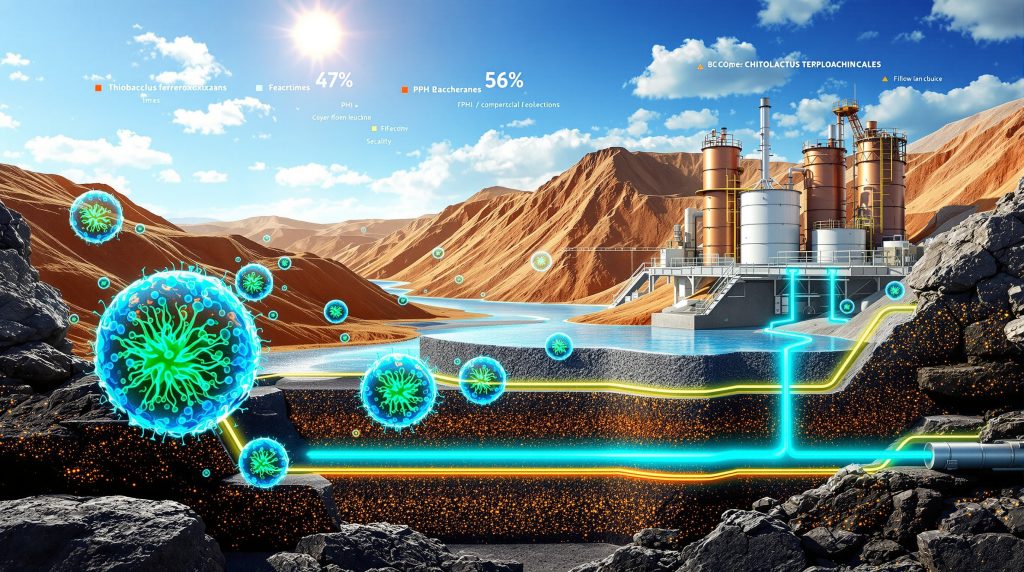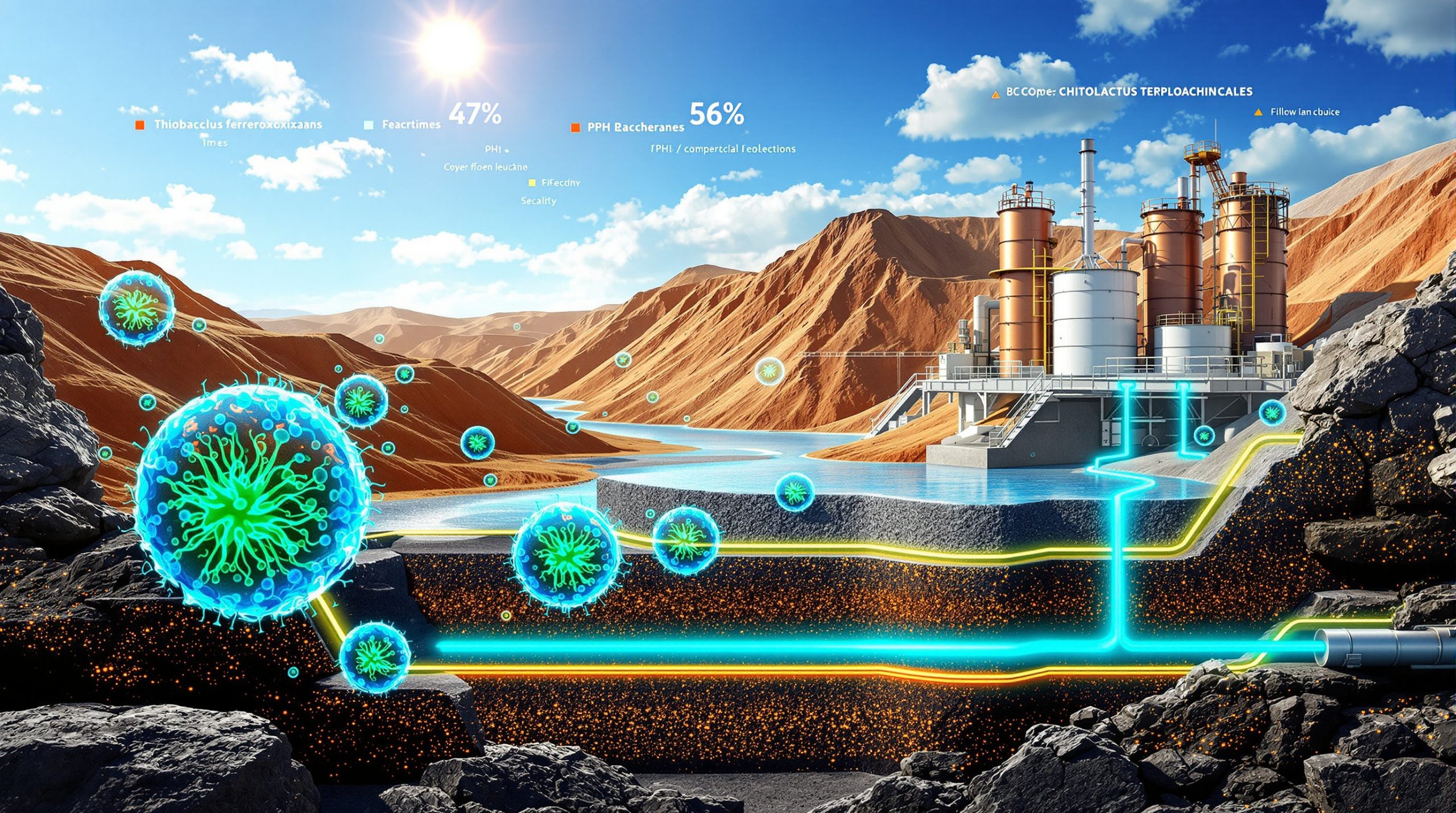Mining operations worldwide face an unprecedented challenge: declining ore grades and complex mineralogy strain traditional extraction methods while global metal demand accelerates beyond conventional supply capabilities. Advanced biotechnology emerges as a transformative solution, leveraging billions of years of microbial evolution to unlock metals from previously uneconomic deposits. This biological approach to mineral processing represents a fundamental shift from energy-intensive smelting toward ambient-temperature systems that work with natural microbial communities rather than against them. The integration of modern mine planning with bioleaching in mining creates new possibilities for sustainable resource extraction.
The convergence of genomics, real-time monitoring, and cloud computing now enables precise control over biological systems that have always existed in mining environments. These microscopic organisms metabolise minerals through established biochemical pathways, converting sulfide compounds and other metallic associations into soluble forms accessible through conventional chemical extraction. Furthermore, the technology addresses critical supply chain vulnerabilities while reducing environmental impact through lower energy consumption and eliminated emissions.
What Is Bioleaching and Why Are Mining Companies Adopting It?
The Science Behind Microbial Metal Extraction
Bioleaching harnesses naturally occurring acidophilic bacteria and archaea that oxidise sulfide minerals through established metabolic processes. These microorganisms have evolved over billions of years to thrive in extreme environments characterised by low pH, high metal concentrations, and elevated temperatures. Unlike pyrometallurgical smelting that requires temperatures exceeding 1,000°C, biological extraction operates at ambient conditions, fundamentally altering the energy equation for metal recovery.
The process relies on bacterial oxidation of sulfur compounds within ore matrices, generating sulfuric acid and ferric iron that dissolve target metals into aqueous solution. This biochemical transformation occurs naturally in acid mine drainage systems, volcanic environments, and deep subsurface zones where microbial communities establish complex ecosystems around mineral-rich substrates.
Traditional smelting processes combust fossil fuels to achieve thermal conditions necessary for metal liberation, generating substantial carbon dioxide and sulfur dioxide emissions. However, biological systems eliminate these thermal requirements while maintaining effective metal recovery rates, particularly advantageous for processing lower-grade deposits that become uneconomic through conventional routes.
Economic Drivers Reshaping Extraction Strategies
Global copper demand exemplifies the supply-demand imbalance driving biotechnology adoption across mining sectors. The International Energy Agency projects steep increases in copper requirements through 2040, while S&P Global estimates demand could double by 2035. In addition, data centre infrastructure expansion alone contributes over 1 million tonnes of additional annual copper demand before decade's end, representing substantial incremental requirements beyond traditional applications.
Declining head grades compound supply challenges as mines exhaust higher-grade ore bodies, forcing operations toward increasingly marginal deposits. Even modest percentage improvements in metal recovery can transform district economics by extending mine life and reducing waste rock processing requirements. Moreover, operations managing large legacy stockpiles find particular value in biological approaches that extract residual metals from previously processed material.
Capital expenditure advantages become pronounced when comparing bioleaching in mining infrastructure to conventional smelting facilities. Heap leaching systems require liner installation, solution collection networks, and monitoring equipment but avoid the massive furnaces, gas handling systems, and high-temperature materials essential for pyrometallurgical operations. Consequently, this cost differential enables smaller-scale operations and modular expansion based on ore body characteristics.
The United States recently designated copper as a critical mineral alongside lithium, nickel, graphite, and rare earth elements, reflecting strategic concerns about supply chain vulnerability. Any technology that enhances domestic metal recovery from existing infrastructure gains importance for national security and industrial competitiveness considerations, particularly through data-driven mining operations.
Which Microorganisms Drive Bioleaching Success?
Primary Bacterial Species in Commercial Operations
Thiobacillus ferrooxidans serves as the foundational species for iron and sulfur oxidation in most commercial bioleaching applications. This chemolithotroph derives energy from oxidising ferrous iron to ferric iron and elemental sulfur to sulfate, generating the acidic conditions necessary for metal solubilisation. The organism tolerates pH levels below 2.0 while maintaining metabolic activity across temperature ranges from 10°C to 37°C, making it suitable for diverse geographic and seasonal conditions.
Thiobacillus thiooxidans specialises in sulfur metabolism, particularly effective when processing sulfur-rich ore bodies or managing sulfur accumulation from other bacterial activities. This species produces sulfuric acid through sulfur oxidation, maintaining the acidic environment essential for continued metal extraction while preventing sulfur precipitation that could inhibit overall process efficiency.
Archaeal species including Metallosphaera and Sulfolobus demonstrate exceptional performance in high-temperature environments above 60°C, enabling bioleaching applications in tropical climates or geothermally active regions. These thermophilic organisms maintain higher metabolic rates at elevated temperatures, potentially accelerating processing timelines compared to mesophilic bacteria.
Microbial Community Engineering and Optimisation
Genomic identification techniques enable precise characterisation of microbial strains exhibiting superior performance characteristics for specific mineralogies. Advanced sequencing platforms analyse community composition, metabolic potential, and adaptive capacity, guiding selection of optimal bacterial consortiums for particular ore types. Furthermore, this molecular approach replaces traditional culture-based methods that failed to capture the full diversity of mineralogically active organisms.
Adaptive evolution protocols encourage development of enhanced metabolic traits through controlled selection pressure applied to microbial populations. Laboratory-scale systems expose bacterial communities to target ore compositions under gradually intensified conditions, promoting survival and reproduction of strains demonstrating improved metal extraction capabilities. These evolved populations often outperform wild-type communities when transferred to commercial operations.
Real-time monitoring systems track microbial population dynamics through continuous measurement of pH, oxidation-reduction potential, temperature, and dissolved metal concentrations. IoT sensors deployed throughout heap and tank systems generate data streams that indicate bacterial activity levels, community health, and optimal conditions for sustained performance. Cloud computing platforms analyse these signals to provide operational recommendations and early warning of population crashes or contamination events.
What Are the Main Bioleaching Process Technologies?
Heap Leaching Operations and Infrastructure
Heap leaching represents the most widely adopted bioleaching methodology, suitable for large-tonnage, lower-grade ore bodies requiring extended processing periods. Construction begins with impermeable liner systems preventing solution migration into groundwater, followed by drainage networks ensuring complete solution collection and circulation. Ore stacking proceeds in controlled lifts, typically 6-10 metres high, with intermediate layers promoting uniform solution distribution.
Solution circulation systems maintain optimal bacterial environments through controlled irrigation, aeration, and nutrient delivery. Acidic leach solutions containing bacterial communities percolate through ore heaps, dissolving target metals while supporting microbial metabolism. Collection ponds capture pregnant leach solutions for downstream metal recovery through solvent extraction-electrowinning or precipitation processes.
Temperature management becomes critical in climatic extremes where seasonal variations affect bacterial activity. Heating systems maintain minimum temperatures during winter months, while cooling strategies prevent thermal stress during summer periods. pH control prevents excessive acidity that inhibits bacterial growth while maintaining sufficient acid levels for continued metal dissolution.
| Process Method | Processing Time | Capital Cost | Ore Grade Suitability | Recovery Rate |
|---|---|---|---|---|
| Heap Leaching | 6-24 months | Low-Medium | 0.2-2.0% Cu | 60-85% |
| Tank Bioreactors | 3-15 days | High | 0.5-5.0% Cu | 85-95% |
| In-Situ Leaching | 1-5 years | Very Low | 0.1-1.0% Cu | 40-70% |
Agitated Tank Bioreactor Systems
Tank bioreactors offer superior process control through enclosed environments enabling precise management of temperature, pH, oxygen levels, and nutrient concentrations. These systems achieve higher metal recovery rates and reduced processing times compared to heap operations but require substantial capital investment for reactor vessels, agitation equipment, and environmental control systems.
Oxygen delivery becomes paramount in tank systems where bacterial metabolism demands continuous oxidant supply for sustained metal extraction. Forced aeration systems maintain dissolved oxygen concentrations above minimum thresholds while preventing over-aeration that could inhibit certain bacterial species. Advanced control systems monitor and adjust oxygen levels based on real-time bacterial activity measurements.
Continuous processing configurations enable steady-state operation with controlled residence times, while batch processing allows for optimal conditions tailored to specific ore characteristics. The choice between continuous and batch operation depends on ore variability, processing volume requirements, and integration with downstream metal recovery systems.
In-Situ and Dump Leaching Applications
In-situ leaching targets underground ore bodies through injection well networks that deliver bacterial solutions directly to mineral-bearing formations. This approach eliminates mining, crushing, and ore handling costs while enabling metal recovery from deposits that would otherwise remain uneconomic. However, geological control becomes challenging, and recovery rates typically remain lower than surface processing methods.
Dump leaching applies biological systems to legacy waste piles and low-grade stockpiles accumulated over decades of mining operations. These applications often demonstrate favourable economics since ore handling and crushing costs have already been incurred. Bacterial communities established on dump surfaces gradually penetrate waste material, extracting residual metals through slow percolation processes.
Environmental monitoring requirements intensify for in-situ operations where solution containment cannot be guaranteed through engineered liner systems. Groundwater protection demands comprehensive monitoring networks and contingency response protocols should bacterial solutions migrate beyond target zones.
Which Metals Can Be Extracted Through Bioleaching?
Copper Production from Sulfide Ores
Copper bioleaching represents the most mature commercial application, accounting for approximately 20% of global copper production through operations across Chile, Peru, Australia, and other major mining jurisdictions. The process particularly excels with chalcopyrite and chalcocite sulfide minerals that resist conventional flotation but respond effectively to bacterial oxidation.
Integration with solvent extraction-electrowinning (SX-EW) systems enables copper concentration and purification from bioleach solutions. Organic extractants selectively capture copper from pregnant leach solutions, transferring the metal to electrolytic cells that produce cathode copper meeting international purity standards. This integration allows bioleaching in mining operations to deliver final products without requiring smelting infrastructure.
Recent pilots demonstrate measurable improvements in copper release from low-grade sulfide ore when microbial communities are specifically tuned to mineralogical characteristics. These managed biological systems consistently outperform passive bacterial activity, suggesting substantial potential for optimising existing operations and enabling processing of previously marginal deposits.
Precious Metals Recovery from Refractory Ores
Gold extraction from refractory ores benefits significantly from bacterial pretreatment that removes sulfide coatings encapsulating precious metal particles. Arsenopyrite and pyrite matrices often contain microscopic gold inclusions inaccessible to direct cyanidation but released following bacterial oxidation of the host sulfide minerals. This biooxidation process exposes gold surfaces to subsequent chemical extraction.
Silver recovery enhancement follows similar principles where bacterial systems remove sulfide barriers preventing access to precious metals. Combined gold-silver operations optimise bacterial communities for simultaneous processing of multiple sulfide associations, maximising overall precious metal recovery from complex ore bodies.
Uranium bioleaching applications target sandstone-hosted deposits where uranium minerals associate with organic matter and secondary minerals. Bacterial systems mobilise uranium through oxidation reactions that convert insoluble uranium compounds into soluble uranyl complexes amenable to chemical recovery. However, these applications remain geographically limited due to regulatory constraints and environmental concerns.
Battery Metals and Critical Mineral Applications
Nickel laterite processing represents an emerging application where microbial iron reduction enhances downstream processing efficiency. Certain nickel laterites reveal pathways for bacterial modification of iron mineralogy that improves subsequent acid leaching or hydrometallurgical processing. These early-stage developments could significantly impact global nickel supply chains given the abundance of lateritic resources worldwide.
Cobalt recovery from polymetallic sulfide concentrates benefits from biological pretreatment that selectively oxidises specific mineral phases while preserving others. Complex sulfide assemblages containing cobalt often require sophisticated processing routes, and bacterial systems offer potential for selective metal extraction without complete ore dissolution.
Lithium extraction research focuses on clay-bound deposits where lithium ions occupy interlayer positions within clay mineral structures. Early investigations suggest that certain microbial consortia may facilitate lithium release from specific clay horizons through mechanisms involving clay mineral modification or organic acid production. While still experimental, these approaches could unlock vast lithium resources currently inaccessible through conventional processing, particularly through innovative lithium extraction methods.
What Are the Environmental and Economic Advantages?
Emission Reduction Compared to Traditional Smelting
Bioleaching in mining operations eliminate sulfur dioxide emissions entirely while reducing energy consumption by 30-50% compared to conventional pyrometallurgical processing. Traditional copper smelting generates approximately 2-4 tonnes of carbon dioxide per tonne of copper produced, primarily from fossil fuel combustion required to achieve processing temperatures. Ambient-temperature biological systems avoid these thermal energy requirements while maintaining effective metal recovery rates.
Water consumption advantages become particularly significant in arid regions where mining operations compete with agricultural and municipal users for limited water resources. Biological systems operate with lower water consumption per unit of metal recovered compared to flotation-smelting processing routes, and solutions can often be recycled multiple times before requiring treatment or disposal.
Air quality improvements extend beyond eliminated sulfur dioxide to include reduced particulate emissions from smelting operations. Communities surrounding bioleaching facilities experience substantially lower air pollution loads, eliminating health concerns associated with heavy metal particulates and acid gas emissions from conventional processing.
Waste Stream Minimisation and Site Remediation
Acid mine drainage treatment through controlled bioleaching offers environmental benefits by transforming environmental liabilities into potential revenue streams. Sites experiencing uncontrolled bacterial activity generating acidic drainage can be engineered into managed systems that extract metals while controlling environmental impact. These applications simultaneously address legacy environmental issues and recover economic value from waste materials.
Tailings volume reduction occurs when bioleaching processes achieve higher metal recovery rates from ore, reducing the mass of waste material requiring long-term storage and management. Even modest improvements in recovery efficiency translate into significant reductions in tailings generation over multi-decade mine lives.
Land use efficiency improvements result from bioleaching's ability to process materials in-place or with minimal infrastructure compared to conventional processing facilities. In-situ applications eliminate surface disturbance for mining, while heap leaching requires smaller processing footprints than equivalent-capacity smelting operations.
Bioleaching operations typically reduce energy consumption by 30-50% compared to conventional smelting while eliminating up to 95% of sulfur dioxide emissions. This translates to approximately 2-4 tonnes of CO2 equivalent savings per tonne of copper produced.
What Challenges Limit Bioleaching Implementation?
Processing Time and Production Rate Constraints
Extended leaching cycles significantly impact project economics through delayed cash flow generation compared to conventional processing methods. Heap leaching operations typically require 6-24 months for complete metal extraction, while tank bioreactors achieve faster processing in 3-15 days but at substantially higher capital costs. These timeframes affect project financing, working capital requirements, and overall return on investment calculations.
Seasonal temperature variations create operational challenges in climatic extremes where bacterial activity slows significantly during winter months or excessive heat stress occurs during summer periods. Northern operations may experience several months of reduced bacterial performance, requiring heating systems or alternative processing strategies to maintain production schedules.
Scale-up challenges emerge when transitioning from laboratory demonstrations to commercial operations involving millions of tonnes of ore processing. Bacterial communities that perform effectively in controlled laboratory conditions may struggle with the environmental variability, contamination risks, and operational complexity of full-scale mining operations.
Technical Limitations and Process Control Issues
Microbial population stability becomes problematic when ore compositions vary significantly or when contamination from competing microorganisms disrupts established bacterial communities. Wild yeast, fungi, or incompatible bacterial strains can rapidly overwhelm optimised microbial populations, requiring constant monitoring and periodic re-inoculation to maintain performance.
Solution chemistry management demands sophisticated understanding of interactions between bacterial metabolism, metal speciation, and chemical equilibria. Bacterial inhibition occurs when dissolved metal concentrations exceed toxicity thresholds or when pH levels drift outside optimal ranges. Managing these chemical relationships requires specialised expertise and continuous monitoring systems.
Infrastructure requirements for large-scale heap operations include extensive liner systems, solution management networks, and monitoring equipment that may not be economically justified for smaller deposits. The fixed costs of bioleaching infrastructure create minimum scale requirements that limit applications to substantial ore bodies or consolidated processing of multiple smaller deposits.
How Is Technology Advancing Bioleaching Efficiency?
Digital Monitoring and Process Optimisation
IoT sensor networks deploy throughout bioleaching operations to provide continuous monitoring of critical parameters including pH, temperature, dissolved oxygen, oxidation-reduction potential, and metal concentrations. These systems generate real-time data streams that indicate bacterial activity levels, community health, and optimal conditions for sustained performance across large-scale heap and tank operations.
Machine learning algorithms analyse historical performance data to predict bacterial community behaviour under varying operational conditions. These predictive models enable proactive adjustments to maintain optimal bacterial performance while identifying early indicators of population instability or contamination events before they impact metal recovery rates. Furthermore, AI in mining innovation extends these capabilities to complex bacterial system management.
Cloud-based data analytics platforms integrate information from multiple operational sites, enabling comparative analysis and best practice identification across diverse geographic and geological conditions. Operators can benchmark performance metrics, identify optimisation opportunities, and share operational insights across corporate portfolios or industry consortiums.
Genetic Engineering and Synthetic Biology Applications
Enhanced bacterial strains developed through directed evolution or genetic modification demonstrate improved performance characteristics including higher metal tolerance, accelerated metabolism, and resistance to environmental stresses. These engineered organisms potentially achieve superior metal extraction rates while maintaining stability under challenging operational conditions.
Biofilm engineering research focuses on bacterial community structures that optimise mass transfer, electron flow, and metabolic efficiency within mineral processing environments. Controlled biofilm development could enhance bacterial attachment to mineral surfaces while improving overall system stability and resistance to contamination.
Synthetic microbial consortiums combine multiple specialised bacterial species engineered to perform complementary functions within integrated metal extraction systems. These designed communities potentially achieve superior performance compared to naturally occurring bacterial associations while providing greater operational control and predictability.
What Does the Future Hold for Bioleaching in Mining?
Market Growth Projections and Investment Trends
Expanding applications beyond traditional copper operations include increasing research and pilot programmes targeting battery metals, precious metals, and critical mineral recovery. Lithium-bearing clays show early promise for microbial-assisted extraction, while nickel laterites reveal potential pathways for bacterial enhancement of conventional processing routes. These diversified applications could significantly expand the total addressable market for bioleaching technologies.
Integration with circular economy initiatives positions bioleaching as a key technology for urban mining and electronic waste processing. Bacterial systems potentially enable metal recovery from complex waste streams including printed circuit boards, batteries, and industrial process residues where conventional recycling methods prove uneconomical.
Venture capital and corporate research funding increasingly targets biotechnology applications in mineral processing as investors recognise the potential for transformative improvements in metal recovery efficiency and environmental performance. Major mining companies establish dedicated biotechnology research programmes while partnering with specialised firms developing advanced microbial systems as part of broader sustainable mining transformation initiatives.
Regulatory Support and Critical Mineral Security
Government incentives for domestic metal production enhancement include research grants, tax advantages, and streamlined permitting processes for projects incorporating advanced extraction technologies. The strategic importance of critical mineral security drives policy support for technologies that improve recovery from domestic ore bodies and reduce import dependence.
Strategic mineral reserve development through bioleaching could enable economic processing of previously submarginal deposits, effectively expanding national mineral resource bases without requiring discovery of new ore bodies. This capability becomes increasingly important as geopolitical tensions affect international mineral trade relationships.
International technology transfer programmes facilitate knowledge sharing and capability development between developed and developing mining jurisdictions. These initiatives accelerate global adoption of bioleaching technologies while building technical expertise in regions with substantial mineral resources but limited processing infrastructure.
Bioleaching uses naturally occurring bacteria to extract metals from ores through biological oxidation processes. The technology offers environmental advantages over traditional smelting while enabling economic recovery from low-grade deposits that would otherwise remain unprocessed.
Frequently Asked Questions About Bioleaching
How Long Does Bioleaching Take Compared to Traditional Methods?
Processing timelines vary significantly by application method and ore characteristics. Heap leaching operations typically require 6-24 months for complete metal extraction, substantially longer than conventional smelting but enabling processing of lower-grade materials that would be uneconomical through traditional routes. Tank bioreactor systems achieve faster processing in 3-15 days but require higher capital investment for controlled environment infrastructure.
Can Bioleaching Work in Cold Climate Mining Operations?
Bacterial communities maintain metabolic activity at temperatures as low as 10°C, though processing rates slow significantly compared to optimal temperature ranges. Cold climate operations may require heating systems to maintain minimum bacterial performance during winter months, or seasonal processing schedules that concentrate bacterial activity during warmer periods. Thermophilic bacterial strains offer potential solutions for consistent year-round operation in challenging climatic conditions.
What Ore Grades Make Bioleaching Economically Viable?
Economic viability depends on multiple factors including metal prices, processing costs, and alternative processing options. Heap leaching typically becomes attractive for copper grades between 0.2-2.0%, while tank bioreactors can process higher-grade materials up to 5.0% copper. The technology particularly excels with refractory ores or complex mineralogies that resist conventional processing methods regardless of grade.
How Does Bioleaching Affect Local Water Resources?
Water consumption generally remains lower than conventional flotation-smelting processes, and solutions can often be recycled multiple times before requiring treatment. However, solution containment becomes critical to prevent contamination of local groundwater resources. Properly designed operations include comprehensive liner systems, monitoring networks, and contingency response protocols to protect environmental resources while maintaining operational efficiency.
Ready to Capitalise on the Next Major Mineral Discovery?
Discovery Alert delivers instant notifications on significant ASX mineral discoveries using its proprietary Discovery IQ model, transforming complex geological data into actionable investment insights that could benefit from advanced extraction technologies like bioleaching. Begin your 30-day free trial today and understand why major mineral discoveries have historically generated substantial returns for early investors positioning themselves ahead of the market.




